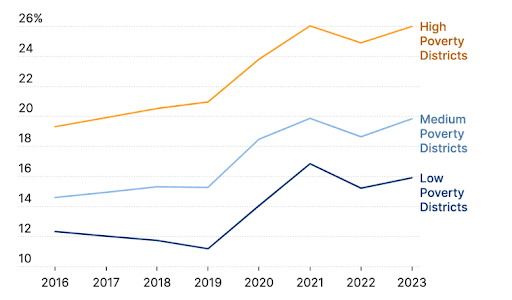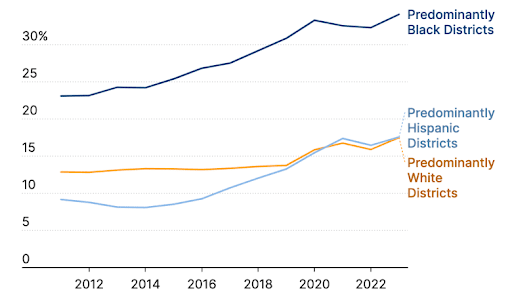Resource: Brookings, “Decreasing public college registration,” August 2025
Independent school registration level
Before the pandemic, the share of trainees in conventional public institutions held stable, hovering near 85 percent between 2016 and 2020 After the pandemic, conventional public college registration plunged to listed below 80 percent and hasn’t recoiled.
The mysterious absent children represent a big piece of the decline. Yet households additionally switched over to charter and online institutions. Charter college enrollment increased from 5 percent of students in 2016 – 17 to 6 percent in 2023 – 24 The number of kids going to online colleges nearly doubled from 0. 7 percent prior to the pandemic in 2019 – 20 to 1 2 percent in 2020 – 21 and has continued to be raised.
Remarkably, private school enrollment has remained stable at almost 9 percent of school-age kids in between 2016 – 17 and 2023 – 24, according to this Brookings price quote.
I had actually expected independent school enrollment to increase, as family members soured on public institution disruptions during the pandemic, and as 11 states, consisting of Arizona and Florida, launched their own instructional savings account or new voucher programs to help pay the tuition. But another evaluation , launched this month by scientists at Tulane University, resembled the Brookings numbers. It discovered that private school enrollments had increased by just 3 to 4 percent in between 2021 and 2024, contrasted to states without coupons. A brand-new federal tax credit scores to fund private school scholarships is still more than a year away from going into impact on Jan. 1, 2027, and maybe a greater shift right into private education and learning is still in advance.
Defections from conventional public schools are biggest in Black and high-poverty districts
I would have presumed that wealthier households that can manage private school tuition would certainly be more likely to look for options. However high-poverty areas had the largest share of pupils outside the conventional public-school market. Along with private school, they were enlisted in charters, virtual institutions, specialized schools for students with handicaps or other alternate schools, or were homeschooling.
More than 1 in 4 trainees in high-poverty areas aren’t signed up in a typical public college, compared to 1 in 6 students in low-poverty institution areas. The steepest public school registration losses are concentrated in mostly Black institution areas. A third of students in mainly Black districts are not in conventional public colleges, double the share of white and Hispanic students.
Share of trainee enrollment beyond traditional public colleges, by district destitution

Resource: Brookings, “Decreasing public school enrollment,” August 2025
Share of pupils not registered in conventional public schools by race and ethnic culture

Resource: Brookings, “Decreasing public school registration,” August 2025
These discrepancies matter for the pupils who stay in conventional public colleges. Schools in low-income and Black communities are now losing the most trainees, compeling even steeper budget plan cuts.
The group timebomb
Before the pandemic, U.S. institutions were currently headed for a large contraction. The average American female is currently giving birth to just 1 7 children over her life time, well listed below the 2 1 fertility price needed to replace the population. Fertility rates are forecasted to fall further still. The Brookings analysts think even more immigrants will remain to get in the country, in spite of current migration limitations, yet not nearly enough to offset the decline in births.
Also if family members return to their pre-pandemic enrollment patterns, the population decline would certainly suggest 2 2 million fewer public school trainees by 2050 But if moms and dads maintain choosing other type of schools at the rate observed since 2020, conventional public colleges can shed as lots of as 8 5 million pupils, shrinking from 43 06 million in 2023 – 24 to as couple of as 34 57 million by mid-century.
In between trainees gone missing, the choices some Black families and households in high-poverty areas are making and the amount of kids are being born, the public college landscape is changing. Twist up and get ready for mass public institution closures
This tale concerning institution enrollment declines was generated by The Hechinger Record , a not-for-profit, independent wire service focused on inequality and innovation in education and learning. Sign up for Evidence Points and various other Hechinger e-newsletters